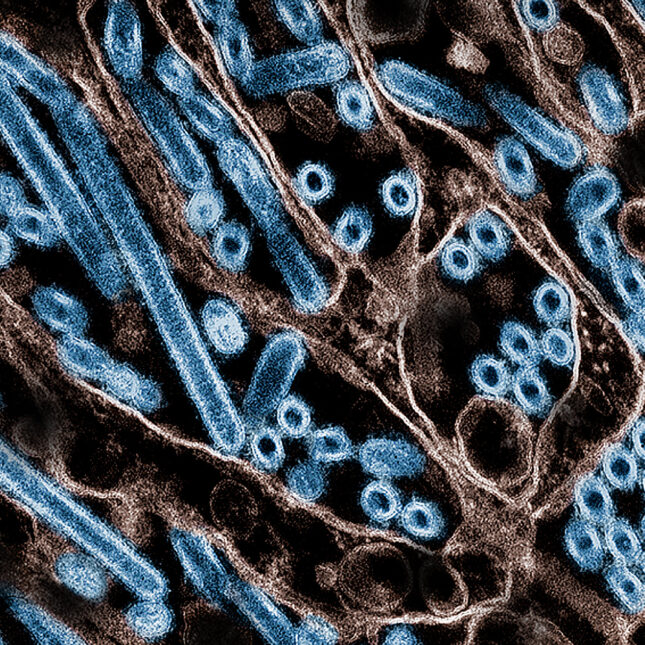
Disease investigators have not been able to determine how a person in Missouri with no known exposures to animals or poultry became infected with an H5 bird flu virus, the principal deputy director of the Centers for Disease Control and Prevention said Thursday.
But Nirav Shah said the ongoing investigation has turned up no evidence of onward spread of the virus, suggesting this case may turn out to be a one-off infection that defies explanation.
“Here’s the bottom line: Our influenza surveillance system is designed to find needles in haystacks,” Shah said at a news briefing. “Here in this case, we found such a needle, but we don’t know how it got there. Our investigation continues, and we will keep everyone updated as we learn more.”
Shah also revealed that, to date, the CDC has not been able to determine the full subtype of the H5 virus, explaining that the amount of RNA in the patient’s specimen was low. The agency is continuing to try to identify the neuraminidase or N of the virus, but Shah acknowledged that may not be possible in this case. Under those circumstances, the CDC would not be able to generate a full genetic sequence of the virus from the Missouri patient.
Analysis that the CDC has been able to conduct shows that the hemagglutinin — the surface protein that gives the virus its H number — is closely related to the H5 viruses that have been circulating in dairy cow herds in multiple states, Shah said.
Missouri is not one of the 14 states that have reported outbreaks in dairy cattle.
As of Thursday, the U.S. Department of Agriculture has confirmed 203 infected herds since the virus was first identified as the cause of a decline in milk production in some dairy cattle in late March. It is believed the outbreak began in late 2023 or early 2024, likely in the Texas Panhandle, with virus from infected wild birds making its way into the cattle and then moving from cow to cow and farm to farm.
Missouri’s Department of Health and Senior Services is leading the investigation on the ground. The individual, who has recovered, is cooperating with state authorities, Shah said. He noted there have been discussions with the person and his or her close contacts about providing blood samples to test for antibodies to the virus — work that could determine if someone close to the individual had an undetected infection that was passed on to this person. It is too soon to draw blood samples for such an effort, Shah said, adding that Missouri is ready to conduct this work if the individuals close to the infected person agree to take part.
The unnamed individual went into hospital on Aug. 22 with symptoms that are not typically associated with influenza — chest pain, nausea, vomiting, diarrhea, and weakness. This person had multiple pre-existing health conditions, Shah noted. In the course of the work-up, a flu test was ordered, which led to the discovery of the mysterious H5 infection.
It isn’t unheard of to have cases in which investigators fail to be able to trace a human infection with novel flu viruses back to a source of infection, Shah said, noting that of the more than 500 swine flu infections that have been detected in the U.S. since 2010, about 8% have been in people with no traceable contact with pigs or other infected people.
Shah also revealed that the CDC is working with commercial companies that make diagnostic tests to get them working on developing H5N1 tests, in case there is a need for them down the road. At the start of the Covid-19 pandemic, the CDC developed a faulty test and it and the Food and Drug Administration were slow to involve commercial testing companies in the process of test development, realities that both hampered the country’s early Covid response and drew enormous criticism for the CDC.
Five companies — Aegis, ARUP, Ginkgo BioWorks, Labcorp, and Quest — have been brought into the effort. “We know that, when the next response with laboratory needs arises — and nowadays, that’s all of them— we’ll need to have contracts with commercial labs. This initiative does that now rather than in the emergency,” Shah said.
In addition to making tests for H5N1, the companies are being tasked to develop tests for Oropouche virus. The agency expects to spend $5 million on this work this month, and could spend up to $118 million over the next five years, if needed.
In related news, Eric Deeble, the USDA’s point person for the H5N1 outbreak response, revealed that California is using bulk tank testing to try to determine the scope of its H5N1 outbreak. The state, which is the nation’s largest dairy-producing state, revealed in late August that it had detected the bird flu virus on three farms in the Central Valley. Since then it has found another five infected herds through testing of operations with links to the farms that were initially detected.
And there may be more positive herds to come. A spokesman for California’s Department of Food and Agriculture told STAT that it had gone over the records of the first three affected farms, looking for other operations with which they had had connections — such as the movement of cattle — in the 30 days before the outbreak was first detected.
CDFA is using bulk tank testing to check those farms and others in the same vicinity for evidence of infected cows, Steve Lyle said, adding: “We have several more on our list to test.”
Correction: An earlier version of this article and a subheadline misstated how many states have detected bird flu outbreaks in dairy cattle.






